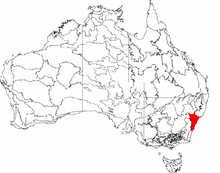Wonnarua
| Wonnarua people | |
|---|---|
|
aka: Wanaruah, Wanaruwa, Wonnuaruah, Wannerawa, Wonarura and Wonnahare Wonnarua (AIATSIS), nd (SIL)[1] | |
|
Hunter Region bioregion | |
| Hierarchy | |
| Language family: | Pama–Nyungan[2] |
| Language branch: | Yuin–Kuric |
| Language group: | (??) |
| Group dialects: |
Awabakal;[2] Darkinjung[3] |
| Area (approx. 5,200 sq. km) | |
| Bioregion: | Hunter Region |
| Location: | Upper Hunter Valley, New South Wales |
| Coordinates: | 32°35′S 150°50′E / 32.583°S 150.833°ECoordinates: 32°35′S 150°50′E / 32.583°S 150.833°E[4] |
| Mountains: |
Liverpool Range;[3] Barrington Tops[5] |
| Rivers |
Upper Hunter River;[4] Allyn River;[6] Williams River[7] |
| Other geological: | Yengo National Park[6] |
| Notable individuals | |
| Jackey Jackey | |
The Wonnarua people /hwənʊrjuːɑːr/, a group of indigenous people of Australia, are those Australian Aborigines that were united by a common language, strong ties of kinship and survived as skilled hunter–fisher–gatherers in family groups or clans scattered along the inland area of what is now known as the Upper Hunter Valley, New South Wales, Australia. Their traditional territory spreads from the Upper Hunter River, near Maitland west to the Great Dividing Range, towards Wollombi.
Meaning people of the hills and plains, the Wonnarua were bounded to the south by the Darkinjung, to the north–west by the Nganyaywana, to the north–east by the Awabakal, and to the south–east by the Worimi peoples. The Wonnarua also had trade and ceremonial links with the Kamilaroi people. Their creation spirit is Baiami, also known as Koin, the creator of all things and the Keeper of the Valley.[8]
Alternate names
A range of alternate names for the Wonnarua people are Wanaruah, Wanaruwa, Wonnuaruah, Wannerawa, Wonarura, and Wonnahare.[1]
Clans
The Gringai are a known clan of the Worimi people, whose traditional lands are the Allyn River valley,[9] and include what is now known as Dungog, Paterson, Gresford, Brookfield,[7] Tocal,[10] to the headwaters of the Williams and Chichester rivers.[7] Gringai land also includes the southern valleys of the Barrington Tops.[5]
Language
The Wonnarua people appeared to use a similar language to the Awabakal people, called Awabakal language, that is being reviewed by oral historians and linguists in order to develop a comprehensive dictionary of the language of the Hunter River and Lake Macquarie regions.[2] However, it has also been claimed that the language of the Wonnarua people is more closely linked to the Darkinjung language.[3]
Native Title
Between 2010 and 2015 the Wonnarua people lodged a total of eight separate native title claims with the National Native title tribunal; the claims have not proceeded any further. In every claim lodged it was clear that the Plains Clans of the Wonnarua People (PCWP) do not recognise or acknowledge that a sub clan was associated with the Wonnarua people. This statement was made by a person who has no connection to the registered native title claimant group. The Awabakal people have lodged a claim that was registered asserting the Gringai are a sub clan of their people, Awabakal people are a tribe bordering the Wonnarua and the Gringai are a sub clan of the Worimi.
The claims are:[11]
- Wonnarua Traditional Custodians #3 NC2015/002 NSD1295/2015 26/10/2015 – Did not pass the registration test. The claim is yet to be notified.
- Wonnarua Traditional Custodians #4 NC2015/003 NSD1296/2015 26/10/2015 – Discontinued
- Wonnarua Traditional Custodians NC2013/003 NSD781/2013 13/05/2013 – Active
- Plains Clans of the Wonnarua People NC2013/004 NSD788/2013 13/05/2013 – Active
- Wonnarua Traditional Custodians NC2012/005 NSD1169/2012 15/08/2012 – Active
- Plains Clans of the Wonnarua People #2 NC2012/004 NSD1093/2012 02/08/2012 – Active
- Awabakal People NC2012/003 NSD951/2012 04/07/2012 – Discontinued
- Scott Franks and Anor on behalf of the Plains Clans of the Wonnarua People NC2013/006 NSD1680/2013 19/08/2013 – Active
Notable Wonnarua people
- Jackey Jackey – a guide and companion to surveyor Edmund Kennedy.[8]
References
- 1 2 Dousset, Laurent (2005). "Wonnarua". AusAnthrop Australian Aboriginal tribal database. Retrieved 10 May 2012.
- 1 2 3 Lissarrague, Amanda (2006). "A salvage grammar and wordlist of the language from the Hunter River and Lake Macquarie" (PDF). Muurrbay Aboriginal Language and Culture Cooperative. ISBN 0-9775351-0-X.
- 1 2 3 Miller, Robert (1886–1887). "No. 188 The Hunter River". In Curr, Edward. The Australian race: its origins, languages, customs, place of landing in Australia, and the routes by which it spread itself over that continent (PDF). III. Melbourne: Government Printer. pp. 352–357.
- 1 2 Tindale, Norman (1974). "Wonnarua (NSW)". Aboriginal Tribes of Australia (online extract). South Australian Museum. Retrieved 15 May 2010.
- 1 2 "Aboriginal associations with the park area". Barrington Tops National Park. NSW National Parks & Wildlife Service. Retrieved 13 May 2012.
- 1 2 "Strategic Plan 2009–2019" (PDF). Wonnarua Nation Aboriginal Corporation. Retrieved 13 May 2012.
- 1 2 3 "Indigenous history". Visit Dungog. Dungog Shire Visitor Information Centre. 2009. Retrieved 13 May 2012.
- 1 2 "Maitland History: Wonnarua People". Australian Museum of Clothing and Textiles. Retrieved 12 May 2012.
- ↑ "Caergwrle, Allynbrook". Discover people and places. State Library of New South Wales. 2011. Retrieved 13 May 2012.
- ↑ "Summary of Tocal's history". Tocal Homestead. CB Alexander Foundation. Retrieved 15 April 2009.
- ↑ http://www.nntt.gov.au/searchRegApps/NativeTitleClaims/Pages/default.aspx
External links
- Wonnarua Nation Aboriginal Corporation website
- Wonnarua Nation Aboriginal Corporation Strategic Plan 2009–2012
- Tindale, Norman (1974). "Wonnarua (NSW)". Map of Australian Aboriginal 'Tribal' Boundaries. South Australian Museum. Archived from the original (online) on 17 October 2009. Retrieved 15 May 2010.
- Galvin, Eleanor, ed. (May 2008). "Selected bibliography of material on the Wonnarua / Wanaruah language and people held in the AIATSIS Library" (PDF). Australian Institute of Aboriginal and Torres Strait Islander Studies. Retrieved 16 May 2010.
Further reading
- Miller, James (1985). "About the Wonnarua". Koori: A Will To Win (PDF). Angus & Robertson.
